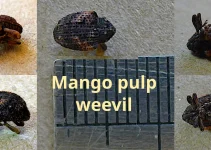Climate change spared not indigenous people’s lives as these stories reveal. Read on to find out how they tried to adapt to the brunt of climate change.
Shift in Weather Condition Affects Upland Agriculture
The indigenous people of Palawan Island like the Palaw’ans observed that there was a sudden shift in weather condition that influenced their planting season in the rain dependent uplands. Normally, they would start planting their slash-and-burn farms when the ground is moist enough to support growing seeds.
The Palaw’ans and other indigenous ethnic groups like the Tagbanua test the soil’s moisture by plunging the sharpened, hollow-end of a bamboo (Schizostachyum lumampao) pole into the ground. When the ground is dry, the soil will fall off from the hollow opening but when it is moist, the soil would stick inside the hollow end. Sudden, earlier than usual downpour would show the latter soil condition and the tribe would start planting their crops. But then they saw their efforts gone to waste when several months later, heavy rains pound the almost ripe grains of rice. They could not predict the whims of the weather.
The sudden changes in weather also led to the pest outbreaks like rat infestations in farmlands. Aside from this, changes in weather can trigger the spread of plant diseases, severely parched crops thus less crop production, and displacement of farmers from their land.
How do the indigenous people adapt to these changes? The two adaptation strategies discussed below was described by Reden, a colleague who was once working with indigenous people in the remote hinterlands of southern Palawan as part of the university’s extension activities.
Adaptation 1. The Old Man and His Handicraft
The old man, an elder of Palaw’an tribe, lives alone in his hut in an isolated part of Culasian in the southern part of Palawan in western Philippines. He subsists on what little yield he can get from a small parcel of land planted with cassava and kaingin (slash-and-burn farm) rice. While awaiting the fruits of his labor, he weaves handicrafts for a living.
This way of life went on for many years until, out of nowhere, a multitude of rats attacked his crops including those of his fellow Palaw’ans. This is the first time that this phenomenon occurred. Everyone suffered because they are living at subsistence level. Subsistence level means they only plant what they need and had nothing in store to feed themselves until next harvest.
One morning, a young tribesman happened to pass by the old man’s house. The young man uttered the usual greetings, but the old man did not respond. Probably he’s asleep, the tribesman thought. He went on his usual way to the mountains to gather whatever edible fruits he can find.
Late in the afternoon when the young man passed the same path again, he saw the old man in the same position he was in the morning. He sensed something was wrong. Curious, the young man came close to the old man sitting on the chair. And he discovered the old man was dead, still holding his handmade craft.
A few days ago, a neighbor said the old man complained of a lack of food just like everyone else who had nothing to harvest that season. To keep his hunger away, he resorted to working on his handicrafts to sell in the nearby village. But his effort proved futile because he died while trying to ebb the tide of hunger. He is no longer fit and strong as the younger members of his tribe to survive days without food.
Adaptation 2. Gleaning the Gleaned Farm
The old man’s adaptation strategy did not work but some of his fellow Palaw’ans survived through other means. One of these strategies is farm gleaning.
I discovered this adaptation strategy accidentally while walking a dirt road on the way back to the city located more than 200 km away. Looking for subjects to photograph in the rural setting, I noticed a family huddled close together next to a pile of rice straw. I took a shot to document the scene (see picture below).

Initially, I thought the family owns the farm and were winnowing grains from their harvest. But when I asked Reden about it, he said those are indigenous people scavenging what was left of the lowlander’s harvest.
This is a pitiful sight because this scavenging activity reflects how poor these people are. Gleaning from what has already been gleaned is difficult.*
Discussion
The problem of global climate change lingers and affects all marginalized people especially those who rely on what nature provides. Those engaged in subsistence farming or hand-to-mouth existence such as the Palaw’ans described in this article are most vulnerable. The severe effects on the food source of the Palaw’ans show how a shift in weather condition can have significant impacts to resource-dependent communities.
A subsistence way of life can have positive benefits to the environment because subsistence living means the least possible extraction of natural resources. This enables the forests and coastal regions to regenerate from minor disturbances inflicted by resource users.
The subsistence way of life, however, seems to be an inefficient response to the effects of climate change. There is a need for the indigenous people to modify their way of life to successfully cope up with the growing threats of global climate change. They need to produce more than what they actually need. This means a greater are of land for planting or more resource extraction activities.
Meanwhile, the scavenging activities show that the Palaw’ans are a resilient people able to survive the challenges of the times. For a minority group with low population, this adaptation would be sufficient to soften the impact of climate change.
These stories show that climate change can change the way of life of resource dependent people. It threatens the very survival of people who for generations lived compatibly with nature.
————
*I missed the rare opportunity to ask a few questions about what the Palaw’ans are doing while on the field. Their self-narrated story would have made this account more interesting. But this is a good lead for research on how indigenous people adapt to the effects of climate change.
I resolved to probe more during my next visit to the place as part of my job as the university extension director at that time but then my work assignment changed and I forgot all about it. This is a lesson that should always be borne in mind by a researcher and an old one at that: “Strike when the iron is hot.” The same opportunity may not come again so exert extra effort each time something interesting like this comes up.
© 2013 September 9 P. A. Regoniel


